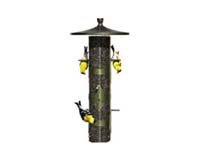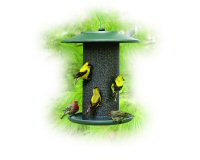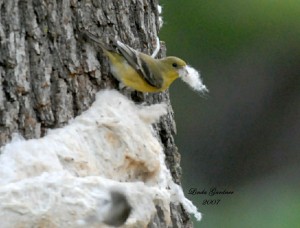-
An Upside Down Thistle Bird Feeder
Thistle seed, also called Nyger is a favorite among birds and humans alike! Many folks choose to feed thistle seed as it will not germinate…leaving no sprouting grass or weeds below the feeder. Goldfinches aren’t the only birds who eat thistle seed–Pine Siskins, Juncos, Indigo Buntings and other Finches, like the House and Purple finch also feast on thistle seed.
You may have seen an upside down thistle bird feeder before, and the reason is that it only appeals to upside down feeding birds like the Goldfinch, Pine Siskin, and Chickadee. House Finches and Purple Finches will not visit this type of feeder as they are unable to peck at seed. If your plain old tube feeder is being overrun by others, and you’d prefer to attract Goldfinches, an upside down thistle bird feeder might be a good choice!
-
A Thistle Feeder and Finch Feeding Tips
Many species of birds will visit your feeders, but unlike most other birds, the Goldfinches’ diet consists mainly of seed. Most finches will feed their chicks insects, while American Goldfinch chicks get the same thistle seed their parents eat. When parents return to feed chicks, it is digested thistle (or nyjer seed), enough for the whole brood. Young are fed about twice an hour, this is why Goldfinches perched at your feeder will eat seed after seed. It’s a great opportunity to view them in detail.
One key to keeping Goldfinches around is eliminating the need to compete. They are known to fly away and give up when other species crowd a thistle feeder. Inexpensive thistle sacks are a good way to offer several separate feeders, thus eliminating the competition for food.
Another important measure is to keep thistle seed fresh. Many times the seed at the bottom of the thistle feeder gets packed down and draws moisture, birds won’t eat spoiled seed. It’s important to completely dump old seed when refilling the feeder.
To enjoy Goldfinches’ vibrant yellow color in warmer months, it’s advised to keep a thistle feeder out year-round, filled with fresh seed at all times.
-
Wood Birdhouses and Nesting Material
With the nesting season approaching for many birds, finding a suitable nest box isn’t always easy. Nesting birds drastically outnumber the available rental units! Having wood birdhouses in your yard greatly helps wild birds nest and raise their young, while also giving life saving shelter and protection from predators.
Goldfinch with Nesting Material In the photo above, an American Goldfinch gathers cotton nesting material for its nest construction. Various materials are used by different species of birds ranging from twigs, grasses, roots, and straw, to feathers, mud, bark, lichens and moss. Commercial nesting materials are available and are of tremendous value to the many types of wild birds. They consist mostly of cotton, feathers, strings, and other tiny shreds of fabrics. Dryer lint works well too! Help out your feathered friends with birdhouses and nesting material before the season starts, and you’re likely to see a “no vacancy” at your birdhouse.



